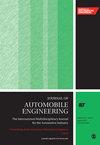A quantitative method of calculating transient nonlinear heat partition coefficient between clutch friction discs with deep learning
IF 1.5
4区 工程技术
Q3 ENGINEERING, MECHANICAL
Proceedings of the Institution of Mechanical Engineers Part D-Journal of Automobile Engineering
Pub Date : 2024-05-18
DOI:10.1177/09544070241247876
引用次数: 0
Abstract
In the current clutch temperature field study, the generally used constant heat partition coefficient tends to overestimate the separator disc temperature and underestimate the friction disc temperature. Although some researchers have found the characteristics of the time-varying heat partition coefficient, a suitable method is still needed to apply it to temperature calculations. This study provides a quantitative method for the application of the transient nonlinear heat partition coefficient to temperature calculations. The finite difference method is adopted to figure out the time-varying curve of the heat partition coefficient by coupling the contact temperature of the friction components. The numerical results show that the heat partition coefficient is independent of rotation speed with three stages: initial value, rapid time-varying, and steady-state. Different from the analytical method, we apply a deep learning method to train the quantisation function to characterise these three stages, avoiding complex formula derivation. As a result, the quantitative function can characterise the time-varying heat partition coefficient accurately, with an average error of 0.19%, 3.05% and 0.62% for the inert, time-varying, and steady-state stages, respectively. In addition, the accuracy of applying the quantisation function in temperature simulation is verified by friction experiments, and the error is less than 8%. This is superior to the results of solving the temperature field by a constant heat partition coefficient.利用深度学习计算离合器摩擦片间瞬态非线性热分配系数的定量方法
在目前的离合器温度现场研究中,一般使用的恒定热分配系数往往会高估分离器盘的温度,而低估摩擦盘的温度。虽然一些研究人员发现了时变热分配系数的特点,但仍需要一种合适的方法将其应用于温度计算。本研究提供了一种将瞬态非线性热分配系数应用于温度计算的定量方法。通过耦合摩擦元件的接触温度,采用有限差分法计算出热分配系数的时变曲线。数值结果表明,热分配系数与转速无关,分为初始值、快速时变和稳态三个阶段。与分析方法不同,我们采用了深度学习方法来训练量化函数,以描述这三个阶段,避免了复杂的公式推导。结果,量化函数可以准确表征时变热分配系数,惰性、时变和稳态阶段的平均误差分别为 0.19%、3.05% 和 0.62%。此外,摩擦实验也验证了在温度模拟中应用量化函数的准确性,误差小于 8%。这优于用恒定热分配系数求解温度场的结果。
本文章由计算机程序翻译,如有差异,请以英文原文为准。
求助全文
约1分钟内获得全文
求助全文
来源期刊

CiteScore
4.40
自引率
17.60%
发文量
263
审稿时长
3.5 months
期刊介绍:
The Journal of Automobile Engineering is an established, high quality multi-disciplinary journal which publishes the very best peer-reviewed science and engineering in the field.
 求助内容:
求助内容: 应助结果提醒方式:
应助结果提醒方式:


